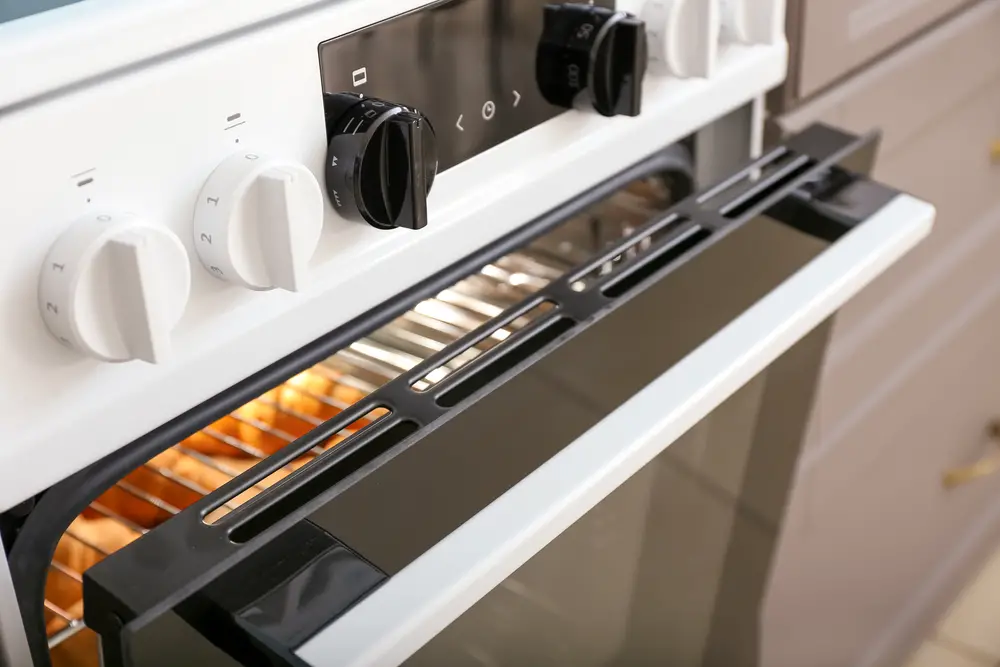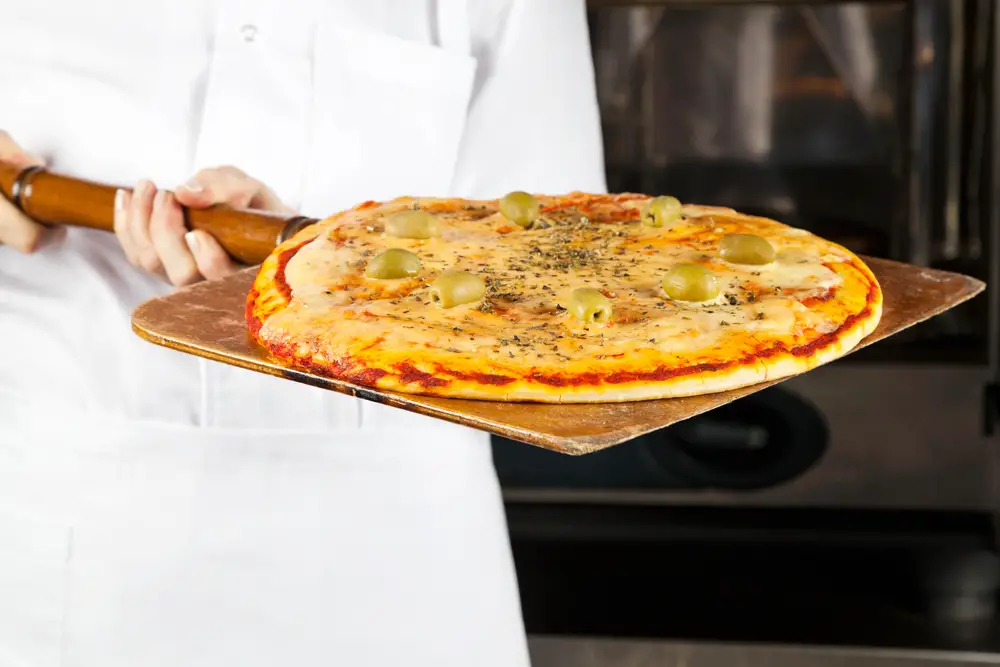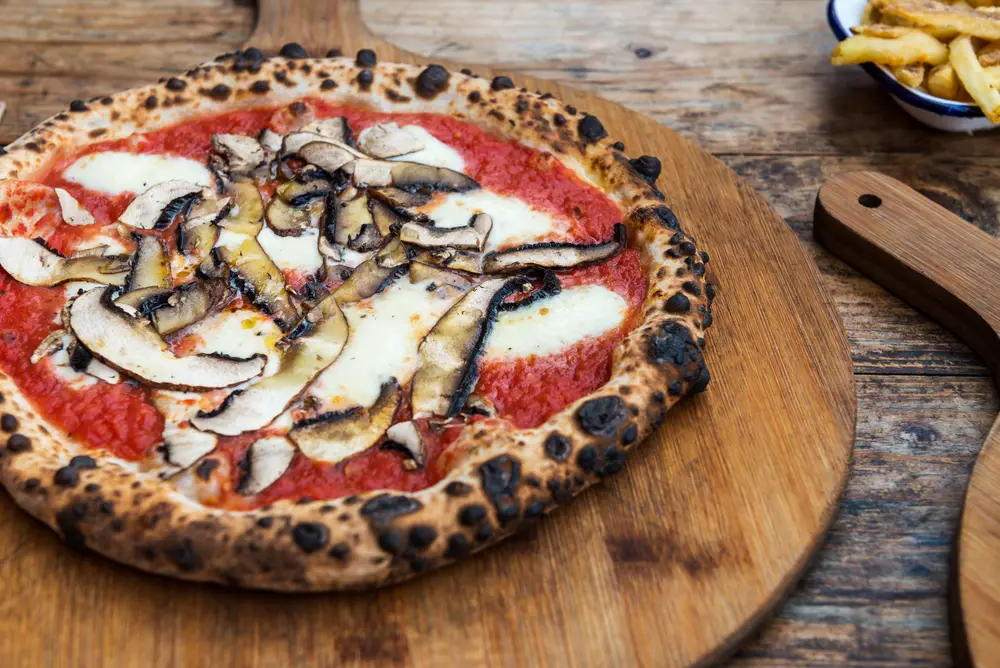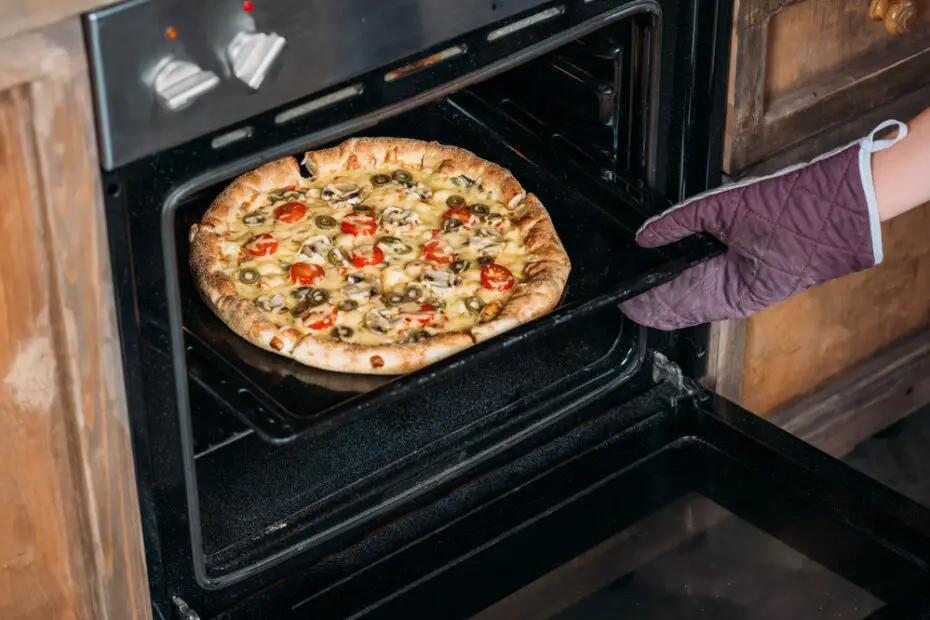Do you want to know how to cook a pizza in a convection oven? Look no further!
Whether you’re making a pizza from scratch or heating up frozen pies, we’ve got the inside scoop on cooking up the best-tasting pizza with that classic crispy crust — every single time!
We’ll let you in on all the secrets for cooking pizza in a convection oven. Once you’re done, you’ll be ready to start whipping up great-tasting pizza!
Read on to learn about:
- The cooking steps with a convection oven
- Tips to getting it right
- Getting the best, crispy pizza crust
- The down-low on convection ovens.
Let’s get baking!
How to Cook a Pizza in a Convection Oven

If you want to prepare a batch of warm, tasty pizza, convection ovens are always a great choice!
However, it can be intimidating trying to use one — especially if you’re not yet used to the device. Here’s how to cook the perfect pizza in a convection oven:
Time and Temperature
Like with other devices, setting the temperature and cooking time depends a lot on your pizza’s crust and the oven you have.
If you’re using a convection oven, you’ll need to heat it to around 400 degrees Fahrenheit and cook the pizza for roughly 12 to 18 minutes!
Do you have store-bought pizza, or are you following a recipe written for a conventional oven? If so, you’ll want to follow the “25 rule”!
The 25 rule simply means lowering your temperature by 25 degrees or cooking the pizza for 25% less time!
That’s because a convection oven heats up a lot faster than a regular oven would, so you might end up with a charred pizza rather than a delicious one if you’re not careful.
How It’s Done – Process
You have your pizza, and your convection oven is ready to bake it to perfection. But how do you go from dough to crispy pie?
Let’s go over the entire process and see step-by-step how it’s done!
Step 1: Adjust the Settings
As mentioned, try to follow the 25 rule whenever possible. Lower the temperature of your convection oven by 25 degrees compared to what would be usually required of a conventional oven!
Remember, convection ovens run hotter.
Step 2: Place Your Pizza
While your oven takes the temperature up, place your pizza on a pizza stone, screen, or pan. If you don’t have one, a standard cookie sheet will do in a pinch!
For an extra crispy base (and who can resist that?), you can even place your pizza directly on the wire oven rack!
Just be careful and check on it from time to time — you don’t want to end up with a gooey pizza mess at the bottom!
Step 3: Put the Pizza in the Oven
Is your oven already preheated and ready to start cooking? Simply put your pizza in the oven.
Pro tip: Choose the middle rack as it’s the Goldilocks zone in terms of oven cooking!
Cook for around 12 to 18 minutes. If you’re following a recipe with specific times, aim for the minimum baking time listed first. Then, gradually increase to get the right blend of softness and crispness that you’re looking for!
Step 4: Crisp the Crust
Nothing beats pizza with a crispy crust! While chewy crusts have their own fervent followers, crispy crusts just have that satisfying crunch that you can’t get anywhere else.
If you’re baking pizza and discover the crust isn’t crisp enough for your liking, feel free to pop it back in for a couple more minutes! Exposing the pizza to heat for longer allows more water to evaporate, leaving you with a crispier pizza.
Just be sure you don’t let it overcook!
Step 5: Remove the Pizza
If you’re happy with how crisp the crust has become and the cheese is visibly bubbling, go ahead and remove the pizza from the oven!
Let it cool for a few more minutes before slicing and serving.
Tips for Making the Perfect Convection Oven Pizza

How you build your pizza will greatly affect how well it cooks in a convection oven!
If you want that perfect pizza that’ll wow your guests, make sure to follow these tips:
1. Use the Right Cheese
The hallmark of a great pizza is using the right cheese!
If you want that delicious and satisfying cheese pull (and who doesn’t?), you’ll want to use cheese that melts really well.
Mozzarella cheese is the classic pick and it’ll leave you with great results each time.
However, don’t be afraid to experiment a little! Who knows — maybe using a blend of different cheeses will leave you with a better result that expands your flavor palette at the same time.
2. Don’t Overdo the Sauce
Sauce is good for many pasta dishes. Pizza? Not so much.
Spreading the sauce too thickly on your pizza can soak up the dough, resulting in a slightly icky, soggy base!
Aside from that, spice-rich sauces can quickly overpower the flavors of your other ingredients, so you might end up just tasting them instead of a complete medley.
The lesson? Use a thin layer of sauce, as this helps to keep your pizza well-balanced!
3. Brown the Cheese
You’ve probably seen that stunning brown cheese look that’s straight out of a cooking magazine — and the good news is you can achieve it at home!
All you need to do is move your pizza from the middle rack to the top during the last few minutes of cooking.
Doing so will help give you an even spread of gooey, bubbling goodness that both looks and tastes awesome!
4. Don’t Forget the Salt
Don’t make the mistake of going through all the trouble of adding toppings and sauces just to forget one simple yet crucial ingredient: salt!
While your ingredients all have something to contribute to the taste, salt elevates the overall flavor profile. Sprinkle in a dash and you’re sure to enjoy a next-level pizza.
5. Experiment with Toppings
Sure, you can go with the classics — bell peppers, black olives, pepperoni, and more. However, making your own pizza means opening the door to a world of opportunities when it comes to toppings!
While you can’t go wrong with the classics, adding something novel can make the process even more enjoyable. Mushrooms, sausage, and seafood? The possibilities are endless!
6. Use a Pizza Peel
Soggy pizza bases that stick to the tray when you remove them from the oven? They may still taste good, but the overall texture could be worlds better.
Next time, why not try dusting the base with a little bit of flour or cornmeal before you cook it?
This pizza peel will help make sure the base doesn’t stick and will leave you with an even crispier crust! In our books, that’s a massive win.
7. Follow Cook Times Carefully
Cook times can differ a lot based on your base, toppings, recipe, and equipment you’re using, so make sure you’re following them as best as you can!
These baking times are very important to make sure the dough and ingredients are cooked through while avoiding any risk of overcooking.
How to Get Crispy Pizza Crust in Convection Oven

If a crispy crust on your pizza is an absolute must for you, don’t worry! There are so many different techniques you can use to get that super crispy crust everyone adores:
Preheat Oven Hot
This one’s a no-brainer! Not only will preheating your oven make sure your pizza cooks evenly and quickly, but it’ll also leave you with that crispy, piping-hot crust.
Again, convection ovens heat up much faster than conventional ones, so this won’t really take up too much time at all.
Use Pizza Stone
If you notice your pizzas aren’t really coming out with that gorgeous, crispy crust, consider getting a pizza stone!
These handy tools help distribute the heat evenly while your pizza is cooking, so you don’t have to worry about soggy pizzas or pirs that are as hard as a brick.
With a pizza stone, you’ll have a pizza with a crispy base all throughout — not just on the edges!
Roll Dough Thin
A thinner pizza base will make for a much crispier bite! If you can, try rolling the dough just half an inch thinner than you typically would.
This small difference elevates your pizza to a whole new level in terms of mouthfeel and satisfaction. Yum!
Bake for a Short Time
If you really don’t want your pizza any other way except for crispy, bake it at higher temperatures for a shorter time.
The heat will quickly vaporize most of the moisture, resulting in a crispy, crunchy experience with every bite.
This method is in direct contrast with the traditional way of baking pizzas for a longer time at lower temperatures, which creates bread with a chewy texture.
Keep an eye on the time, however! If you leave it for too long, the pizza will be dry all the way through rather than crispy on the outside and fluffy on the inside.
Monitor to Prevent Burning
Aside from being dry, leaving your pizza for too long can make you taste charcoal rather than the toppings. It’s crucial that you monitor your pizza to avoid any culinary catastrophes!
Rotate for Even Cooking
While convection ovens are known for even cooking, it’s still a great idea to manually rotate the pizza every now and then.
Some sections of the oven can get hotter than others, so rotating the pizza can help it cook evenly and become crispy all the way through.
Use the Convection Fan
What’s the best setting for a convection oven when baking pizza? That would be the convection fan!
Simply switch it on and allow it to work its magic. This way, you’ll be distributing heat around the insides of the oven.
The result? Pizza that’s not just cooked evenly but is also crisped to perfection!
Remove When Edges Are Golden Brown
If you want an easy, visual cue for when your pizza is cooked well, check its edges.
When these are already golden brown, you can remove the pizza from the oven!
Cool before Slicing
It’s hard to resist pizza, especially when it’s piping hot and flooding your nose with delicious aromas. But hold that thought!
Instead of digging right in, let your pizza cool for a few more minutes before slicing.
Cutting into it immediately can ruin the toppings and rob the crispy crust of the opportunity to set properly.
A Convection Oven: Is It Worth It?
If you love pizza that’s cooked evenly and has that perfect crispy base, you can’t go wrong with a convection oven!
This device has all of the necessary features to distribute heat evenly all throughout, resulting in perfect pizza every time.
Convection ovens also heat faster than regular ones, so preheating your oven takes no time at all!
You can pop in as many pizzas (with crispy crusts) as you like without taking nearly as much time as a conventional oven would. This alone makes convection ovens a worthwhile investment!
Tips For How To Cook A Frozen Pizza In A Convection Oven
Do you want to cook a frozen pizza to perfection using your convection oven?
No problem at all! Check out these tips for an incredible pizza that doesn’t taste like it was once frozen:
- Alter the temperature. Remember the 25 rule! Convection ovens heat faster than regular ovens, so you’ll have to adjust the cooking instructions on the box. For instance, lower your temperature by 25 degrees below what the box recommends, or cook the pizza for 25% less time.
- Preheat your oven. For faster and more even cooking and a crispier base, always preheat your oven. This is especially true for frozen pizzas which are notorious for coming out of the oven with soggy bases.
Having an already hot oven from the get-go helps vaporize the moisture, elevating the overall pizza experience. - Add your own toppings. Sure, frozen pizzas are great for when you’re feeling lazy — but don’t be afraid to add your own toppings!
Put a twist on store-bought pizza by adding a few fresh ingredients. A sprinkle of cheese or a drizzling of your favorite sauce will go a long way — just don’t overdo it! - Monitor your pizza. Be sure to check in on your frozen pizza frequently throughout the cooking process. Since you’ll need to adjust cooking instructions with convection ovens, keep a close eye on your pizza to prevent burning.
- Utilize the convection fan. This is the most useful part of the convection oven and what sets it apart from other equipment. The fan distributes heat evenly, creating a great pizza even if it was store-bought and frozen!
FAQs
Is a convection oven better for baking?
A convection oven isn’t necessarily the best for all-around baking. That’s because the rapid circulation of hot air cooks the surface of foods very quickly!
It creates an effect similar to microwaves: charred outside, raw inside. In many situations, conventional ovens have the edge.
What is the best temperature for pizza in a convection oven?
The best temperature for baking pizza using a convection oven is around 400 degrees Fahrenheit.
As we’ve said, this gives you an even bake that also has the benefit of a crispy crust.
However, different factors such as pizza thickness can increase or decrease the right temperature. Keep experimenting!
Are convection ovens any good?
If you just want to crisp up some foods, convection ovens have your back. That’s why they’re so great for cooking pizza and roasting meats or vegetables!
Just remember that convection ovens aren’t a one-size-fits-all tool for all your cooking needs. If you can, have both conventional and convection ovens in your kitchen!
As someone from Long Island, New York, Thomas knows what it takes to make a good pizza. He understands that it’s a combination of high-quality ingredients, well-rounded pizza ovens, and a little bit of love. From the dough of a Neapolitan-style pizza to the wood that powers a wood-fired pizza oven, he has you covered. Thomas’ love of pizza is what got him here and he hopes that you’ll enjoy pizza as much as he does soon.
